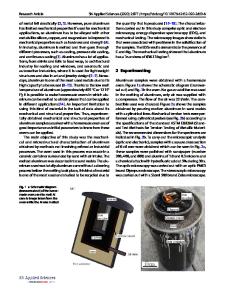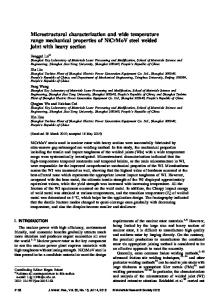Mechanical and Microstructural Characterization of an Aluminum Bearing Trip Steel
- PDF / 2,322,267 Bytes
- 7 Pages / 593.972 x 792 pts Page_size
- 92 Downloads / 362 Views
ODUCTION
STEELS that exhibit the phenomenon known as transformation-induced plasticity (TRIP for short) are characterized by an attractive combination of high strength and ductility. The microstructure of these steels is made of a complex aggregate of phases and structures that consist, in general, of ferrite, bainite, and retained austenite, but in some cases martensite and carbides may be present. Their characteristic high strength and ductility are obtained in cold-rolled steels by subjecting them to a specific two-stage heat treatment that consists of an intercritical annealing stage (between Ac1 and Ac3) followed by isothermal transformation within the bainitic region. The length of the isothermal treatment in the bainitic region is critical, as a minimum amount of untransformed (retained) austenite is required to achieve the TRIP-effect.[1–4] Tensile strength between 600 and 800 MPa, together with deformation to fracture above 25 pct of TRIP-assisted steels are determined by a combination of a ferrite matrix, for ductility, bainite, for strength, and an ALBERTO MONSALVE, Metallurgical Engineer, Full Time Professor, ALEXIS GUZMA´N, Metallurgical Engineer, ALFREDO ARTIGAS, Metallurgical Engineer, Full Time Professor, LINTON CARVAJAL, Metallurgical Engineer, Full Time Professor, and OSCAR BUSTOS, Metallurgical Engineer, Full Time Professor, are with the Departamento de Ingenierı´ a Metalu´rgica, Facultad de Ingenierı´ a, Universidad de Santiago de Chile, Santiago, Chile. Contact e-mail: [email protected] FLAVIO DE BARBIERI, Mechanical Engineer, Full Time Researcher, is with the Direccio´n de Proyectos, Investigacio´n y Desarrollo de la Armada, Valparaı´ so, Chile. NELSON F. GARZA-MONTES-DE OCA, Metallurgical Engineer, Full Time Professor, and RAFAEL COLA´S, Metallurgical Engineer, Full Time Professor, are with the Facultad de Ingenierı´ a Meca´nica y Ele´ctrica, Universidad Auto´noma de Nuevo Leo´n, Mexico. Manuscript submitted March 7, 2015. Article published online March 28, 2016 3088—VOLUME 47A, JUNE 2016
appropriate volume fraction of metastable retained austenite that will transform into martensite during deformation enhancing ductility. From this point of view, the carbon content and the size, distribution and crystallographic orientation of the retained austenite are the parameters that determine its transformational stability. Enhancement of ductility in TRIP-assisted steels results from the increment in the work hardening rate,[5] which delays the onset of different types of plastic instability (necking being the macroscopic manifestation of such in a tensile test). Increment in strength in these steels is associated with the increase in dislocation density promoted by the change in volume associated with the transformation.[1,6] Chemical composition exerts an effect on the amount of retained austenite.[7–9] It is known that aluminum and silicon stabilize ferrite, although the former to a lesser extent[10–12] with the drawback that high contents of silicon promote the formation of surface oxides suc
Data Loading...











